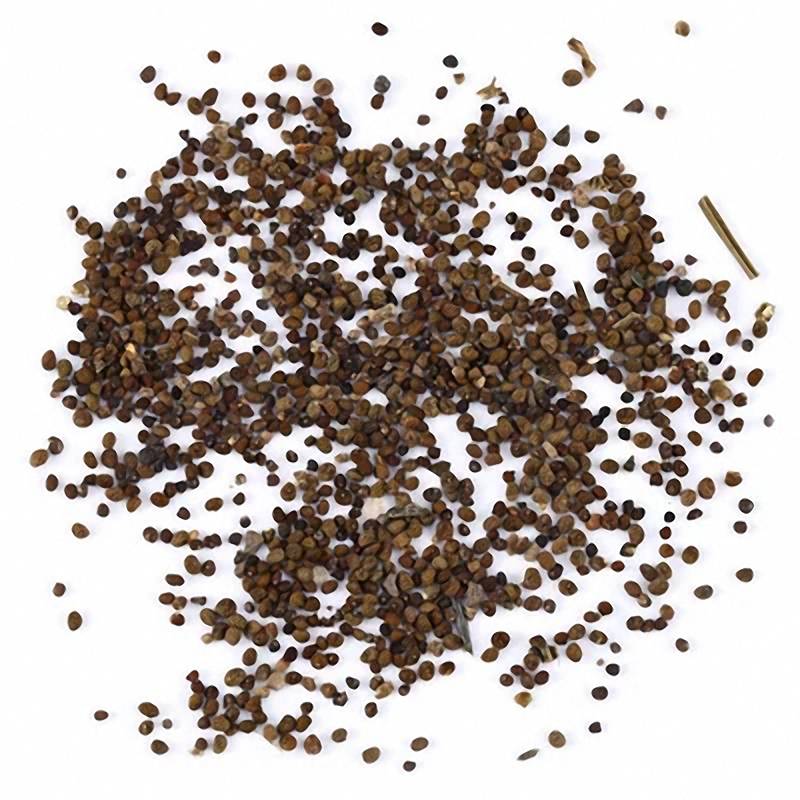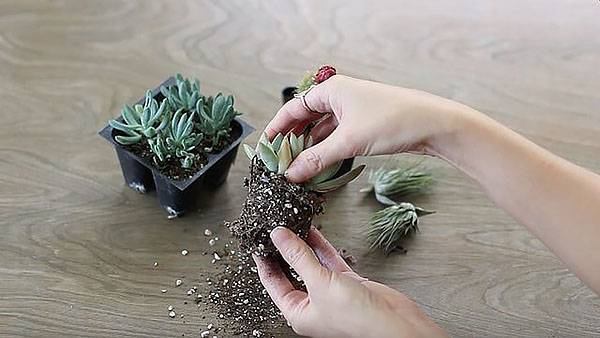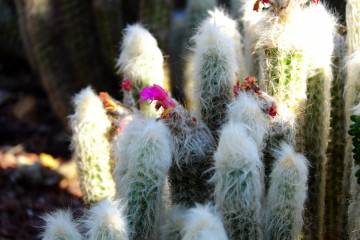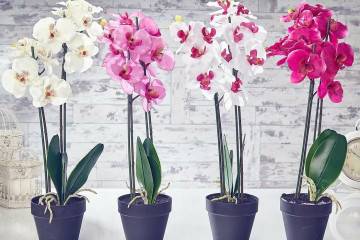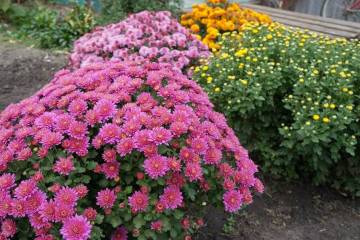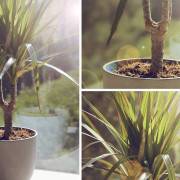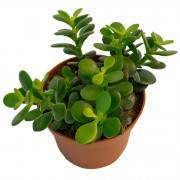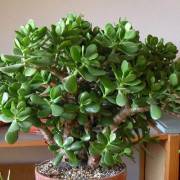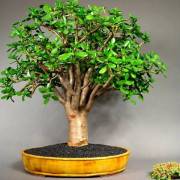Soil for succulents: transplanting and growing options
Content:
Although succulents are not picky about watering, they are very demanding on soil composition and lighting. Due to the improperly selected soil structure, both cacti and leafy representatives of the jumbo genus can either develop poorly or die altogether. To prevent this from happening, you need to know how to grow succulents and what kind of soil suits them.
Criteria for the selection of soil for planting
When choosing a soil for succulents, it is not so important to pay attention to acidity. What kind of land is needed for succulents? The main thing is that it should be:
- loose and permeable to water and air. The soil for succulents must quickly absorb moisture and dry out. Not the slightest stagnation of water should be allowed;
- sufficiently drained. Many succulents in the natural environment live on the slopes of rocks, so small pebbles and coarse sand can even be added to ready-made soil that was purchased at the store. Without drainage, moisture will stagnate and the plant will die;
- moderately nutritious. Thanks to the beneficial minerals, succulents will have flowers. However, an overabundance of trace elements will not benefit the plants. Humus or excessive nitrogen will cause cacti to grow rapidly. They will crack the top layer of the crust, and the plant will be covered with ugly buds and scars.
DIY soil for succulents
Different types of succulents have their own requirements for the composition of the soil.
Required components
Before you start preparing soil for succulents with your own hands, you need to remember one thing - no matter what flower the soil is intended for, 3 elements must be present in it: turf and leafy soil, as well as sand. Then everything depends on the root system of the plant.
If we are talking about small and thin roots that are located very close to the surface of the earth, then pebbles or heavily crushed red brick should also be added to the soil for succulents and cacti. A crumb from a brick absorbs moisture well, thus preventing stagnation of water in the soil.
For thick roots, the composition of the soil may be slightly different, because the root system itself is capable of accumulating a certain amount of moisture. In this case, loamy soil will be suitable, which can be in the form of the same sod land.
Substrate proportion
To prepare the soil for plants with small roots, you need to mix all the necessary components, strictly observing the proportions: sod and leafy soil, as well as sand, must be taken in equal amounts. To them add ½ part of crushed brick. For crops with a powerful root system, leafy soil and sand are taken in equal amounts, and 1/5 of the sod land is added to them.
Succulent growing options
To answer the question of how to plant succulents, you first need to familiarize yourself with the processes of their reproduction. There are several options. You can breed plants using cuttings, leaves and seeds. If you adhere to all the recommendations from experts, then any of this method will be effective, and a new representative of the home flora will quickly appear on the windowsill. And over time, you even have to think about how to transplant succulents.
Leaf propagation is only suitable for those types of succulents in which they are thick and fleshy. For varieties with thin leaves, propagation by cuttings is used.
First of all, you need to properly prepare the planting material. This requires:
- Choose an absolutely healthy leaf or stalk.
- Take a sharp knife and wipe it with a disinfectant.
- Cut off the leaf / stalk at the very base.
If juice is released from the cutting, it must be washed off with filtered water, and then sprinkled with crushed activated carbon over the cut site. Then the stalk can be germinated in water, only you need to make sure that it does not touch the bottom of the container. You can also germinate planting material in fine-grained sand. For this, the cutting is planted no deeper than 2 cm and is well fixed with fine gravel. The planted plant must be watered.
The germination process will be crowned with success if a stable temperature regime of about 23-25 ° C is maintained in the room. The root remedy will also benefit the plant.
The leaf is rooted a little differently. For him, you need to prepare a well-disinfected soil. For this, either sand or a special substrate purchased in the store is suitable, to which sand or fine-grained expanded clay is added. The leaf does not need to be planted in the ground; it is placed on dry soil at an angle so that it is convenient for it to take root.
Further, the offshoot needs proper care.
- Watering the leaf is not worth it, it is necessary to spray it periodically.
- The pot is placed in a bright place, but drafts and direct sunlight must be excluded.
- When the leaf has roots, it is planted in a special substrate for succulents.
- When the top layer of the earth dries out, the sprouted leaf needs to be watered.
From seed
To achieve successful cultivation of succulents from seeds, you must clearly adhere to all the recommendations from experienced florists who know a lot of secrets on how to grow succulents from seeds.
- To begin with, it is worth choosing the right container for sowing. There are several options here. You can buy a special container at a flower shop or use a regular plastic container that comes with a transparent lid. You can also put several small pots in a regular box and cover them with foil.
- Selection of quality soil. The seed is very sensitive to the environment. Therefore, if there is no desire to buy high-quality soil in a specialized store, then independently mined soil, sand and gravel must be well disinfected.
- Correct seeding. To plant the seeds neatly and not damage them, you need to take a piece of paper and bend it in the middle. Pour all the seeds on it, and then, tapping a stick on top of the leaf, sow them into the soil. From above, the seeds are covered with a substrate or sand, the thickness of which should not exceed 2 mm, as well as the size of the seeds themselves.
- If desired, the florist can install plates near them, where the name of the sown seeds will be indicated.
- After planting the seeds, they need to be watered. To do this, use warm filtered water. Watering must be done exclusively from a spray bottle, so as not to erode the soil, and also to avoid burying the seeds into the soil.
- Then the planted seeds are covered with a lid or foil and are not removed until the young shoots are sufficiently strong. This period lasts approximately until the sprouts reach a height of 2 cm.
For succulents like aloe or gasteria, perlite is a good choice because it retains moisture. The main thing is not to forget to water such soil well before planting seeds.
Home care
Now that it has become known how to plant succulents, you need to figure out the rules for caring for them. Succulents are not very capricious plants, but they still require compliance with some rules.
- Climatic conditions. Given that this species mainly refers to desert plants, it is important for it to provide a dry climate and temperature drops. Flowers should take a break from the heat of the day at night. It is good if the room is about 26 ° C during the day, although 30 ° C is allowed in summer, and at night the temperature should drop to 20 ° C.
- Lighting. These flowers love bright light, so they are best placed on the south side. If this is not possible, and the windows of the house face the north side, then you need to take care of additional lighting. As for direct sunlight, it all depends on the type of flowers. Cacti mainly belong to plants that can easily tolerate the sun, but it is better not to expose aloe and duvalia to the sun's rays.
- Watering. Although succulents do not need frequent watering, it should still be well-oiled. From spring to autumn, depending on how the soil dries up, the soil is irrigated once every 1-2 weeks. In winter, the plant is in a dormant period, so watering should be significantly reduced. Depending on the temperature regime, the flowers can be watered either once a month or once a winter. In the summer, the main thing is to prevent the roots from drying out, but the soil must remain dry for at least 3 days.
- Top dressing. Fertilize plants with special agents that are designed for succulents. The soil should not be oversaturated with nitrogen. In winter, flowers are not fertilized at all, and in spring, fertilizing is applied once a month.
Also very important in terms of care is the question of how to transplant succulents at home. This process is practically no different from transplanting other plant species. It is necessary to chicken out the old earthen lump, spread the root system in a new pot and fill it with new soil. However, there is one peculiarity of transplanting succulents - during the first week, the plant does not need to be watered.
No matter how hardy succulents may seem, they are still very sensitive to the environment and require attention, like other plants. If you surround them with warmth and care, then the florarium will sparkle with different colors and will delight the eyes of any guest.



